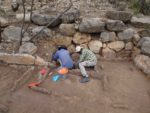 Archaeologists excavating in Harlaa, eastern Ethiopia, have discovered the remains of a major Islamic city dating as far back as the 10th century. Local farmers have been finding archaeological remains and artifacts for years — pottery, coins, some from China, and masonry structures whose large stones inspired legends that a race of giants once lived there and built appositely giant buildings for themselves. Even with this evidence that there was something of historical significance in Harlaa, the site was neglected by archaeologists. The area has such an extraordinarily rich prehistorical fossil record, particularly as regards early hominids, that its later history has been overshadowed.
Archaeologists excavating in Harlaa, eastern Ethiopia, have discovered the remains of a major Islamic city dating as far back as the 10th century. Local farmers have been finding archaeological remains and artifacts for years — pottery, coins, some from China, and masonry structures whose large stones inspired legends that a race of giants once lived there and built appositely giant buildings for themselves. Even with this evidence that there was something of historical significance in Harlaa, the site was neglected by archaeologists. The area has such an extraordinarily rich prehistorical fossil record, particularly as regards early hominids, that its later history has been overshadowed.
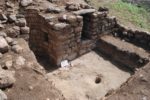 An international team of archaeologists from Britain’s University of Exeter, Addis Ababa University in Ethiopia and the University of Leuven in Belgium stepped into the breach two years ago, working with the residents who have a wealth of previously untapped knowledge. The excavation has unearthed the remains of a 12th century mosque, Islamic graves and headstones, a wide variety of beads made of glass, rock crystal and carnelian and fragments of glass vessels. The Chinese coins found by the farmers turned out to be just scraping the surface of how far ancient Harlaa’s trade networks reached. Archaeologists found imported cowry shells, coins from 13th century Egypt and pottery from Madagascar, the Maldives, Yemen and China.
An international team of archaeologists from Britain’s University of Exeter, Addis Ababa University in Ethiopia and the University of Leuven in Belgium stepped into the breach two years ago, working with the residents who have a wealth of previously untapped knowledge. The excavation has unearthed the remains of a 12th century mosque, Islamic graves and headstones, a wide variety of beads made of glass, rock crystal and carnelian and fragments of glass vessels. The Chinese coins found by the farmers turned out to be just scraping the surface of how far ancient Harlaa’s trade networks reached. Archaeologists found imported cowry shells, coins from 13th century Egypt and pottery from Madagascar, the Maldives, Yemen and China.
Professor Timothy Insoll, from the Institute of Arabic and Islamic Studies at the University of Exeter, who led the research, said: “This discovery revolutionises our understanding of trade in an archaeologically neglected part of Ethiopia. What we have found shows this area was the centre of trade in that region. The city was a rich, cosmopolitan centre for jewellery making and pieces were then taken to be sold around the region and beyond. Residents of Harlaa were a mixed community of foreigners and local people who traded with others in the Red Sea, Indian Ocean and possibly as far away as the Arabian Gulf.”
Harlaa is 120km from the Red Sea coast and 300km from Addis Adaba. The architecture of the mosque is similar to those found in Southern Tanzania and Somaliland, showing connections between different Islamic communities in Africa.
Remains found in the dig suggest jewellers were making high-quality, delicate pieces in silver, bronze and semi-precious stones and glass beads. They used some technology usually associated in that period with jewellers in India, suggesting trade or immigration from that country to Harlaa.
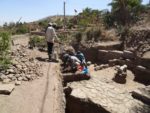 The Islamic-era settlement as excavated thus far appears to have been populated between the 10th and 15th centuries and is about 500 meters (.3 miles) by 1,000 meters. The use of large stone blocks to build walls and structures is consistent throughout the site, hence the giants idea. The locals, by the way, aren’t convinced that the giants theory is wrong. They think the 300 bodies found in the cemetery may have been the giants’ children. Samples of the remains are being studied to determine the diets and health of the ancient residents of Harlaa.
The Islamic-era settlement as excavated thus far appears to have been populated between the 10th and 15th centuries and is about 500 meters (.3 miles) by 1,000 meters. The use of large stone blocks to build walls and structures is consistent throughout the site, hence the giants idea. The locals, by the way, aren’t convinced that the giants theory is wrong. They think the 300 bodies found in the cemetery may have been the giants’ children. Samples of the remains are being studied to determine the diets and health of the ancient residents of Harlaa.
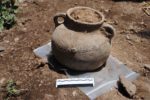 The archaeological team will return next year to continue excavating. They want to dig deeper and cover more sites to discover more about the earlier history of the area.
The archaeological team will return next year to continue excavating. They want to dig deeper and cover more sites to discover more about the earlier history of the area.
Professor Insoll said: “We know jewellery was being made here for trading into the African interior, and materials to do this came in from the Red Sea, East African Coast and possibly India, but we don’t know what was given in exchange for that jewellery. During the next stage of our archaeological research in this era we hope to examine this by working on other sites up to 100km away.”
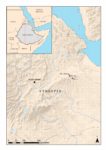 The Harlaa excavation was done in partnership with the Ethiopian Authority for Research and Conservation of Cultural Heritage and many of the artifacts will be go on public display at a local heritage center. It will provide jobs for the community and, the hope is, bring tourist money and a new understanding and appreciation for the Islamic history of the area and of Ethiopia in general. A selection of artifacts will be exhibited at the National Museum of Ethiopia in Addis Ababa where they will be in most illustrious company. The skeletal remains of the internationally famous Australopithecus afarensis Lucy are kept there (although the display version is a plaster replica).
The Harlaa excavation was done in partnership with the Ethiopian Authority for Research and Conservation of Cultural Heritage and many of the artifacts will be go on public display at a local heritage center. It will provide jobs for the community and, the hope is, bring tourist money and a new understanding and appreciation for the Islamic history of the area and of Ethiopia in general. A selection of artifacts will be exhibited at the National Museum of Ethiopia in Addis Ababa where they will be in most illustrious company. The skeletal remains of the internationally famous Australopithecus afarensis Lucy are kept there (although the display version is a plaster replica).